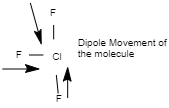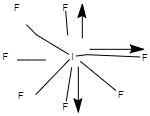
The molecule with zero dipole moment is?
A. \[Cl{F_3}\]
B. \[Br{F_{_5}}\]
C. \[I{F_7}\]
D. \[ClF\]
Answer
141.6k+ views
Hint: Dipole moment is a vector quantity and it occurs when the charge is separated. The total amount of dipole movement can be calculated by multiplying the charge with the total distance between the charges.
Formula used<\b>: The dipole movement can be calculated by the given formula;
\[\mu = q.r\]
Where \[q\]stands for the magnitude of the charge that is separated, \[r\] represents the distance that is present between the charges and \[\mu \] represents the dipole moment.
The SI unit to measure the dipole moment is coulomb-metres(C-m).
The direction of the dipole moment is usually from negative to positive charge.
Complete step by step solution:
Dipole movement can occur between the two ions that are linked together by ionic bonds and between two or more atoms that are linked together by covalent bonds. So as per the question stated above, we need to check the net charge that is present:
1. \[Cl{F_3}\]
The structural diagram of \[Cl{F_3}\] is as follows:

Image source: Chemdraw
Since three dipoles are present in the T-shaped molecule which do not cancel out each other, therefore the molecule of \[Cl{F_3}\] is polar i.e. the dipole moment is not zero.
2. \[Br{F_3}\]
The structural formula of \[Br{F_3}\] is as follows:

Image source: Chemdraw
As we can see here, in this T-shaped molecule, the dipole moment does not cancel out each other. There is a huge difference in the electronegativity of fluorine and bromine atoms. This is a highly polar molecule that is often used as a fluorinating agent. So the dipole moment is not zero.
3. \[I{F_7}\]

Image source: Chemdraw
Out of seven, 5 fluorine molecules are placed together in a single plane and their total magnitude and magnitude of the opposite fluorine atoms cancel out each other. Hence, they are non-polar and their resultant dipole moment is zero.
4. \[ClF\]
The structural formula of \[ClF\] is as follows;

Image source: Chemdraw
As per the chemical structure above, we can observe that it has a linear geometry and these are two different elements with different electronegativities. Hence the molecule mentioned above is polar and it has a non-zero dipole moment.
Hence, option C is the correct answer
Note: Molecules may or may not have a polar bond to have a net dipole moment. Many molecules have a polar bond and still have a zero-dipole moment. This is true when the structural formula of the molecules is symmetrical in which the individual dipole bonds cancel out each other.
Formula used<\b>: The dipole movement can be calculated by the given formula;
\[\mu = q.r\]
Where \[q\]stands for the magnitude of the charge that is separated, \[r\] represents the distance that is present between the charges and \[\mu \] represents the dipole moment.
The SI unit to measure the dipole moment is coulomb-metres(C-m).
The direction of the dipole moment is usually from negative to positive charge.
Complete step by step solution:
Dipole movement can occur between the two ions that are linked together by ionic bonds and between two or more atoms that are linked together by covalent bonds. So as per the question stated above, we need to check the net charge that is present:
1. \[Cl{F_3}\]
The structural diagram of \[Cl{F_3}\] is as follows:

Image source: Chemdraw
Since three dipoles are present in the T-shaped molecule which do not cancel out each other, therefore the molecule of \[Cl{F_3}\] is polar i.e. the dipole moment is not zero.
2. \[Br{F_3}\]
The structural formula of \[Br{F_3}\] is as follows:

Image source: Chemdraw
As we can see here, in this T-shaped molecule, the dipole moment does not cancel out each other. There is a huge difference in the electronegativity of fluorine and bromine atoms. This is a highly polar molecule that is often used as a fluorinating agent. So the dipole moment is not zero.
3. \[I{F_7}\]

Image source: Chemdraw
Out of seven, 5 fluorine molecules are placed together in a single plane and their total magnitude and magnitude of the opposite fluorine atoms cancel out each other. Hence, they are non-polar and their resultant dipole moment is zero.
4. \[ClF\]
The structural formula of \[ClF\] is as follows;

Image source: Chemdraw
As per the chemical structure above, we can observe that it has a linear geometry and these are two different elements with different electronegativities. Hence the molecule mentioned above is polar and it has a non-zero dipole moment.
Hence, option C is the correct answer
Note: Molecules may or may not have a polar bond to have a net dipole moment. Many molecules have a polar bond and still have a zero-dipole moment. This is true when the structural formula of the molecules is symmetrical in which the individual dipole bonds cancel out each other.
Recently Updated Pages
Difference Between Crystalline and Amorphous Solid

JEE Main Participating Colleges 2024 - A Complete List of Top Colleges

JEE Main Maths Paper Pattern 2025 – Marking, Sections & Tips

Sign up for JEE Main 2025 Live Classes - Vedantu

JEE Main 2025 Helpline Numbers - Center Contact, Phone Number, Address

JEE Main Course 2025 - Important Updates and Details

Trending doubts
JEE Main 2025 Session 2: Application Form (Out), Exam Dates (Released), Eligibility, & More

JEE Main Exam Marking Scheme: Detailed Breakdown of Marks and Negative Marking

JEE Main 2025: Derivation of Equation of Trajectory in Physics

Electric Field Due to Uniformly Charged Ring for JEE Main 2025 - Formula and Derivation

Types of Solutions

Learn About Angle Of Deviation In Prism: JEE Main Physics 2025

Other Pages
NCERT Solutions for Class 11 Chemistry Chapter 9 Hydrocarbons

JEE Advanced Marks vs Ranks 2025: Understanding Category-wise Qualifying Marks and Previous Year Cut-offs

JEE Advanced 2025: Dates, Registration, Syllabus, Eligibility Criteria and More

NCERT Solutions for Class 11 Chemistry Chapter 5 Thermodynamics

Hydrocarbons Class 11 Notes: CBSE Chemistry Chapter 9

JEE Advanced Weightage 2025 Chapter-Wise for Physics, Maths and Chemistry




